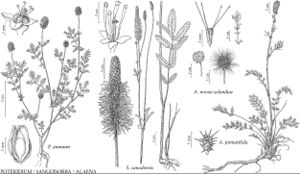Sanguisorba
Sp. Pl. 1: 116. 1753.
Gen. Pl. ed. 5, 53. 1754.
| Taxon | Illustrator ⠉ | |
|---|---|---|
 | Poteridium annuum Sanguisorba canadensis Acaena pinnatifida Acaena novae-zelandiae | Marjorie C. Leggitt Marjorie C. Leggitt Marjorie C. Leggitt Marjorie C. Leggitt |
Herbs, perennial, 2–20 dm; rhizomatous. Stems 1–10+, ascending to erect, glabrous or glabrescent. Leaves deciduous, basal and cauline; stipules persistent, adnate to petiole, free portion usually ovate, obovate, or suborbiculate, margins dentate; petiole present; blade oblongelliptic, 5–55 cm (basal blades largest, cauline reduced distally), herbaceous, leaflets (3–) 7–21, orbiculate, ovate, or oblong, leafy stipels sometimes present on vigorous leaves, margins flat, crenate or serrate, surfaces glabrous or sparsely hairy. Inflorescences terminal or axillary to distal leaves, 50–500+-flowered, spikes, ellipsoid to cylindric, glabrous or variously pubescent; peduncles present; bracts absent; bracteoles present. Pedicels absent. Flowers 2–5 mm diam.; hypanthium urceolate, 1–6 mm, smooth, muricate, or winged, glabrous; sepals 4, basally connate, spreading, petaloid, elliptic to ovate; petals 0; stamens [2–] 4 [–12], shorter or longer than sepals; carpels 1 [or 2], glabrous, styles repeatedly branched, brushlike; ovules pendulous. Fruits achenes, 1, globose, 0.5–2 mm, glabrous; hypanthium persistent, enclosing achenes, dry, hardened, top-shaped to ellipsoid, 2–5 mm, 4-angled or winged, faces smooth between angles; sepals persistent, spreading to ascending. x = 14.
Distribution
North America, n Eurasia
Discussion
Species ca. 15 (4 in the flora).
Sanguisorba is here circumscribed more narrowly than it has been traditionally (for example, H. A. Gleason and A. Cronquist 1991) (though exactly as it was circumscribed by P. A. Rydberg 1908–1918), based on recent molecular phylogenetic analyses summarized in D. Potter et al. (2007), following and refining initial findings by M. S. Kerr (2004). Poteridium and Poterium are in a clade separate from Sanguisorba and basal in Sanguisorbeae, with Sanguisorba then basal to the remainder of Sanguisorbeae (Potter et al.).
Acropetal flowering refers to flowers opening sequentially from the base toward the apex of the inflorescence. Basipetal flowering refers to flowers opening sequentially from the apex toward the base of the inflorescence.
Selected References
None.
Lower Taxa
Key
| 1 | Spikes flowering acropetal, 5–25 cm; calyx lobes white to greenish white, rarely cream to pinkish or slightly purple | > 2 |
| 1 | Spikes flowering basipetal, 1.5–7 cm; calyx lobes purple or dark purple | > 3 |
| 2 | Leaflets oblong-ovate to lance-oblong, lengths ca. 2–4 times widths, bases broadly cuneate, truncate, or rounded to slightly cordate; calyx lobe midveins thickened distally; plants 9–20 dm; c, e North America. | Sanguisorba canadensis |
| 2 | Leaflets ovate-oblong to ovate or suborbiculate, lengths ca. 1.2–2 times widths, bases usually deeply cordate, rarely truncate; calyx lobe midveins not thickened distally; plants 2–12 dm; nw North America. | Sanguisorba stipulata |
| 3 | Stamen lengths 1.5–2.5 times calyx lobes, filaments flattened and dilated in distal 1/2; calyx lobes purple; leaflet lengths 1–2 times widths; spikes cylindric, 1.5–7 cm. | Sanguisorba menziesii |
| 3 | Stamen lengths ± equal to calyx lobes, filaments filiform throughout; calyx lobes dark purple; leaflet lengths 1.5–2.5 times widths; spikes ellipsoid or ovoid, 1.5–3 cm. | Sanguisorba officinalis |
"thin" is not a number.